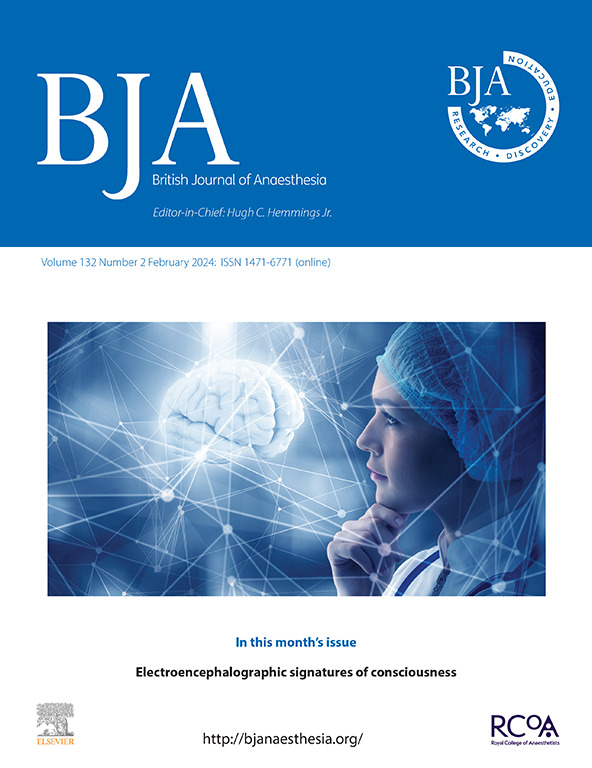Depression in older surgical patients: a multicentre prospective longitudinal study.
IF 9.1
1区 医学
Q1 ANESTHESIOLOGY
引用次数: 0
Abstract
BACKGROUND A longitudinal examination of postoperative depression is important for risk assessment. We aimed to explore the prevalence and trajectory of depression in older surgical patients, before surgery, and at 30, 90, and 180 days after surgery, associated risk factors, and clinical outcomes. METHODS This prospective cohort study assessed 307 male and female surgical patients aged ≥65 yr in two preoperative clinics in Canada. All participants completed an online survey before and after surgery that contained the 15-item Geriatric Depression Scale with a ≥5 cut-off to define depression. We also assessed risk factors and clinical and patient-centred outcomes associated with depression. RESULTS Preoperative depression was present in 20.2% (95% confidence interval [CI]: 16.1-25.1) of participants and 17.6% had potentially unrecognised depression. Overall, 18.7% (95% CI: 14.1-24.3) reported depression at 180 days after surgery. Participants with preoperative cognitive impairment (odds ratio [OR]: 2.91, 95% CI: 1.29-6.61, P=0.010) and sleep disturbances (OR: 2.91, 95% CI: 1.29-7.07, P=0.013) each had three-fold higher odds of preoperative depression. Those with preoperative functional disability had four-fold higher odds of preoperative depression (OR: 4.15, 95% CI: 1.58-11.54, P=0.005) and six-fold higher odds of depression at 180 days after surgery (OR: 5.91, 95% CI: 1.43-29.07, P=0.019). The depression group had 2.5-fold higher odds for non-home discharge (OR: 2.40, 95% CI: 1.08-5.10, P=0.026). CONCLUSIONS The prevalence of depression was 20.2% before surgery and 18.7% at 180 days after surgery. Our findings highlight the interconnectedness of mental health with factors such as function, cognition, and sleep.老年外科患者的抑郁症:一项多中心前瞻性纵向研究。
背景:术后抑郁的纵向检查对风险评估很重要。我们的目的是探讨老年手术患者在术前、术后30天、90天和180天抑郁的患病率和发展轨迹、相关危险因素和临床结果。方法本前瞻性队列研究评估了加拿大两家术前诊所307例年龄≥65岁的男性和女性手术患者。所有参与者在手术前和手术后完成一项在线调查,该调查包含15项老年抑郁症量表,定义抑郁症的截止值≥5。我们还评估了与抑郁症相关的危险因素以及临床和以患者为中心的结果。结果20.2%(95%可信区间[CI]: 16.1 ~ 25.1)的参与者存在术前抑郁,17.6%的参与者存在潜在的未被识别的抑郁。总体而言,18.7% (95% CI: 14.1-24.3)在手术后180天报告抑郁。术前认知障碍(比值比[OR]: 2.91, 95% CI: 1.29-6.61, P=0.010)和睡眠障碍(比值比[OR]: 2.91, 95% CI: 1.29-7.07, P=0.013)的参与者术前抑郁的几率均高出3倍。术前功能障碍患者术前抑郁的几率高出4倍(OR: 4.15, 95% CI: 1.58-11.54, P=0.005),术后180天抑郁的几率高出6倍(OR: 5.91, 95% CI: 1.43-29.07, P=0.019)。抑郁症组非居家出院的几率高出2.5倍(OR: 2.40, 95% CI: 1.08-5.10, P=0.026)。结论术前抑郁患病率为20.2%,术后180 d抑郁患病率为18.7%。我们的发现强调了心理健康与功能、认知和睡眠等因素的相互联系。
本文章由计算机程序翻译,如有差异,请以英文原文为准。
求助全文
约1分钟内获得全文
求助全文
来源期刊
CiteScore
13.50
自引率
7.10%
发文量
488
审稿时长
27 days
期刊介绍:
The British Journal of Anaesthesia (BJA) is a prestigious publication that covers a wide range of topics in anaesthesia, critical care medicine, pain medicine, and perioperative medicine. It aims to disseminate high-impact original research, spanning fundamental, translational, and clinical sciences, as well as clinical practice, technology, education, and training. Additionally, the journal features review articles, notable case reports, correspondence, and special articles that appeal to a broader audience.
The BJA is proudly associated with The Royal College of Anaesthetists, The College of Anaesthesiologists of Ireland, and The Hong Kong College of Anaesthesiologists. This partnership provides members of these esteemed institutions with access to not only the BJA but also its sister publication, BJA Education. It is essential to note that both journals maintain their editorial independence.
Overall, the BJA offers a diverse and comprehensive platform for anaesthetists, critical care physicians, pain specialists, and perioperative medicine practitioners to contribute and stay updated with the latest advancements in their respective fields.

 求助内容:
求助内容: 应助结果提醒方式:
应助结果提醒方式:


